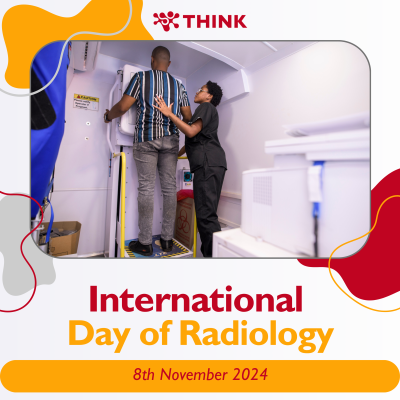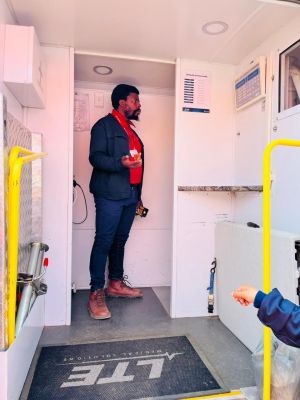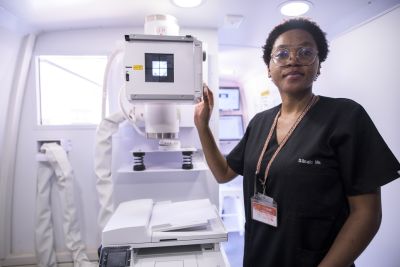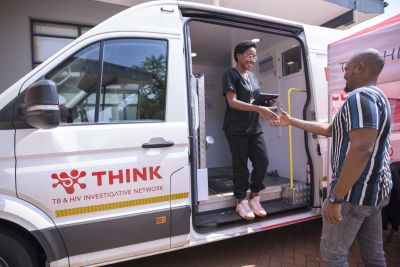As we celebrate the International Day of Radiology on November 8, we want to highlight the significant role that radiography plays in healthcare. Helping to diagnose diseases like tuberculosis (TB), radiography remains a vital part of medical advancements. This is something that Sandile Dludla, a radiographer at THINK South Africa, experiences daily.
Sandile didn’t originally plan to become a radiographer. “My father wanted me to do medicine, but I applied too late and my second choice was radiography, which I was accepted into,” he shares. Like many, he initially had little understanding of the profession and was encouraged to visit a hospital to see what was being done before deciding if it was truly what he wanted. “You know, with the name ‘radiographer’, you might think it’s related to working at a radio station, whereas it’s not at all,” Sandile says humorously.

Celebrating International Day of Radiology 2024
After years of working in government hospitals, Sandile eventually made the move to THINK. “I saw an opportunity, even though I wasn’t quite familiar with the NGO world. I decided to take my chance because you never learn when you’re always in your comfort zone.”
A typical day for Sandile involves managing a team and ensuring that all the equipment is working properly. “You need to plan ahead, manage your team, check your stock and consumables, and make sure your machine is working well. You also need to communicate with the facilities beforehand to ensure people are expecting you.” He emphasises the importance of maintaining organisation and ensuring that staff are feeling well and trained, following proper procedures to protect patient safety. “It’s a meticulous job, but we need to care about our patients’ health.”

Sandile Dludla, a Radiographer at THINK South Africa, Working in Health Systems Improvement
Sandile notes that working in an NGO is quite different from working in a government hospital. At THINK, it involves working in a mobile clinic van, which brings its own challenges and dynamics. With the importance of targeting locations where TB cases are less attended to, Sandile and his team ensure the van and its X-ray capabilities reach areas where the need is the greatest.
One of the most critical aspects of Sandile’s work is the use of technology, especially for diagnosing TB. “We’re able to use X-rays to diagnose TB, both pulmonary and extrapulmonary, and see its impact on the lungs. A doctor with a stethoscope can make wrong assumptions, but X-rays tell you the complete story of what’s happening in the body and help us make the right diagnosis.”
Moreover, AI is playing a vital role in the radiography field, and Sandile has seen its impact firsthand. “AI is a game changer. In the mobile van, we’re using AI for reporting. It uses pattern recognition to screen the chest field and then provides a diagnosis based on the pattern. It can separate the old TB and the new TB, identifying scars and fibrosis, and can even detect fluid in the lungs.” AI is doing wonders, Sandile explains, because humans can have different interpretations of what they see, while AI offers an external, judgement-free, objective opinion.
“We’re able to use X-rays to diagnose TB, both pulmonary and extrapulmonary, and see its impact on the lungs. A doctor with a stethoscope can make wrong assumptions, but X-rays tell you the complete story of what’s happening in the body and help us make the right diagnosis.” – Sandile Dludla

The Chest X-ray Machine
When asked about advice for future radiographers, Sandile is candid. “First, keep in mind that it has nothing to do with the radio station! But it’s still an interesting field, and it’s not going to die anytime soon. Eventually, medicine will evolve, and maybe in the future, we might find ourselves looking into a system where you can be screened from head to toe in a second. Radiology leads the way in new medical technology.”
For Sandile, the most fulfilling part of his job is seeing the positive impact radiography has on the community. “Working in a community is really the best part for me, seeing that you are making a difference. The smiles of your patients when they get their results, knowing that they’re fine. And even if something is wrong, you’re able to refer them to a medical officer to help them. It’s not just an X-ray, there’s a continuation of care, and you truly have a real impact on people’s lives.”
“Working in a community is really the best part for me, seeing that you are making a difference. The smiles of your patients when they get their results, knowing that they’re fine.” – Sandile Dludla

The THINK Mobile Clinic Van with the Chest X-rays
Radiography plays an indispensable role in healthcare, from diagnosing diseases to improving patient outcomes through advanced technology. Sandile Dludla’s dedication to community care and the integration of cutting-edge tools like AI showcase the future of radiology in making a difference in patients’ lives.
Fun Fact: Wilhelm Conrad Röntgen, who in 1895 discovered the X-ray, revolutionised medicine, enabling non-invasive diagnosis of conditions like tuberculosis. Radiography, born from his experiments, has evolved into an indispensable tool in healthcare today. Röntgen’s commitment to making his discovery freely accessible for the good of humanity laid the foundation for advancements that save lives, including the work done by radiographers like Sandile Dludla – who makes a difference at THINK South Africa, everyday.
Léa Haulin
THINK Network Communications Intern 2024
